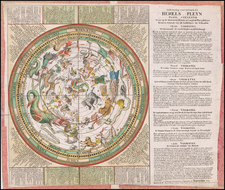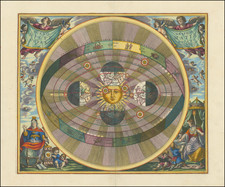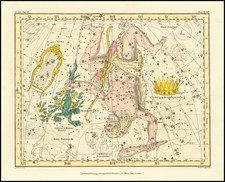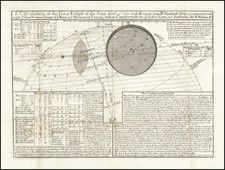Decorative engraved celestial map by Doppelmayr showing the motion of the planets Mercury and Venus during the year 1710. A detailed illustration on the chart shows a league of horses pulling a chariot whose wheels are the rotating earth. This rotates around a central sun figure, alongside the representations of Mercury and Venus as their respective Roman gods.
In 1710, Mercury transited across the sun on November 5th. Astronomers were able to use geometric principles along with revolution speeds (center of chart) of the inner planets to predict where the planets would appear relative to the sun, from the earth. This was used to correctly predict a future transit event in 1761. The sides of the map show the predicted altitude (with regards to the equator) of Mercury and Venus over the year 1710.
The map is typical of the detailed and bold style of the Homann cartographic output, of which the celestial maps are amongst the most attractive.
Johann Baptist Homann (1663-1724) was a mapmaker who founded the famous Homann Heirs publishing company. He lived his entire life in Bavaria, particularly in Nuremberg. Initially, Johann trained to become a priest before converting to Protestantism and working as a notary.
In 1702, Johann founded a publishing house that specialized in engravings. The firm flourished, becoming the leading map publisher in Germany and an important entity in the European map market. In 1715, Johann was named Imperial Geographer to the Holy Roman Empire by Charles VI and made a member of the Prussian Academy of Sciences. Most importantly for his business, his reputation and contacts gained him imperial printing privileges which protected his publications and recommended him to customers. Johann is best known for this Grosser Atlas ueber die ganze Welt, or the Grand Atlas of the World, published in 1716.
After Johann died in 1724, the business passed to his son, Christoph (1703-1730). Upon Christoph’s early death, the company passed to subsequent heirs, with the name of the company changing to Homann Erben, or Homann Heirs. The firm continued in business until 1848.









![[Pegasus, Delphinus, Equueleus]](https://storage.googleapis.com/raremaps/img/small/91233.jpg)


![[ Gemini ]](https://storage.googleapis.com/raremaps/img/small/93254.jpg)

